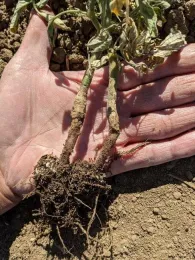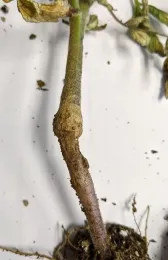Root-inhibiting herbicides (like pendimethalin or trifluralin) are soil-applied and pre-plant incorporated as a standard practice for conventional processing tomatoes in the Sacramento Valley.

Pendimethalin was applied pre-plant, a common practice for this particular grower, but never with this result. So the question remained, “how did this happen?” If the herbicide was only in the top two inches of soil and the transplant plug/root ball is inches below that, how did the plant take up the herbicide to cause this damage?

I was told similar injury (not from pendimethalin specifically but similar herbicides) had been seen more in 2021 on tomatoes than usual, possibly because of the low water at planting.
References
- Weed Science Society of America Herbicide Handbook, 7th Edition, 1994, pages 230-233.
- NC State Extension, Herbicide Injury Factsheets, Root Inhibitors: https://content.ces.ncsu.edu/root-inhibitors

